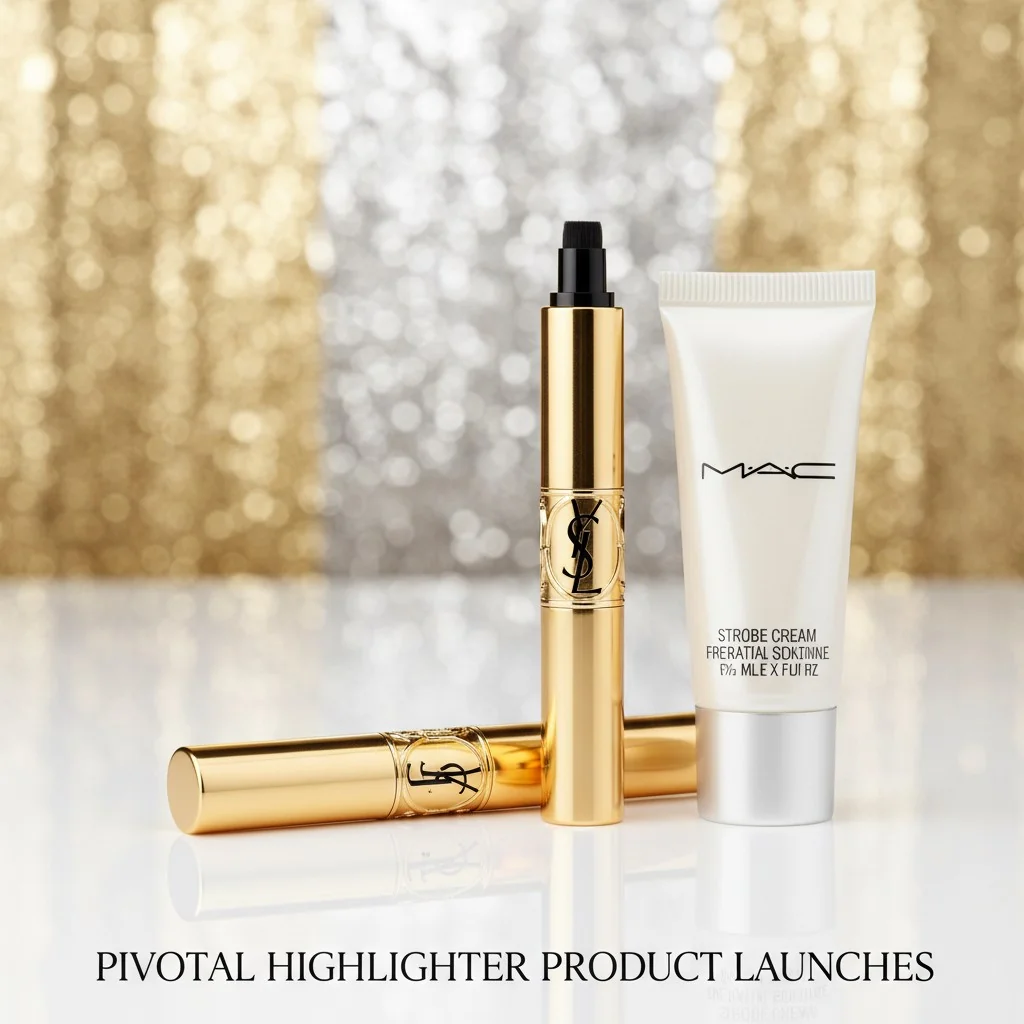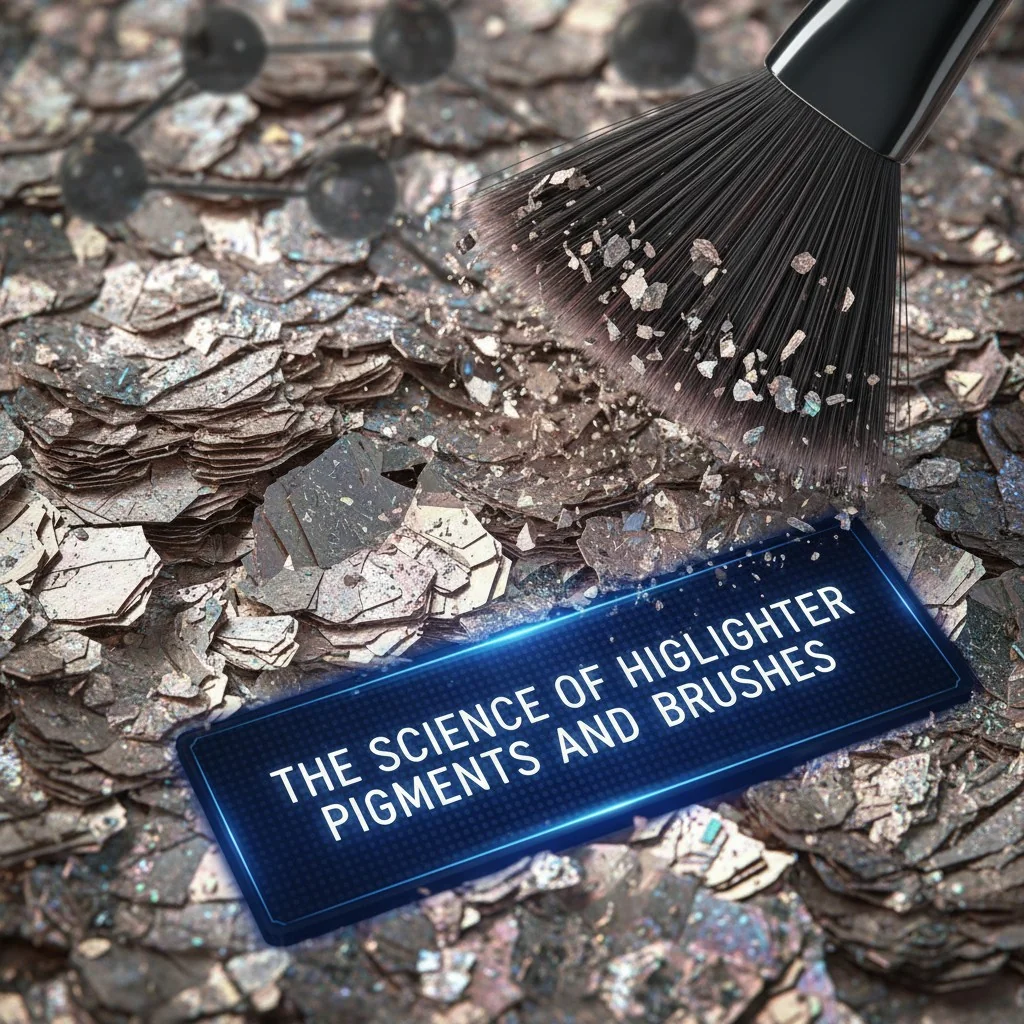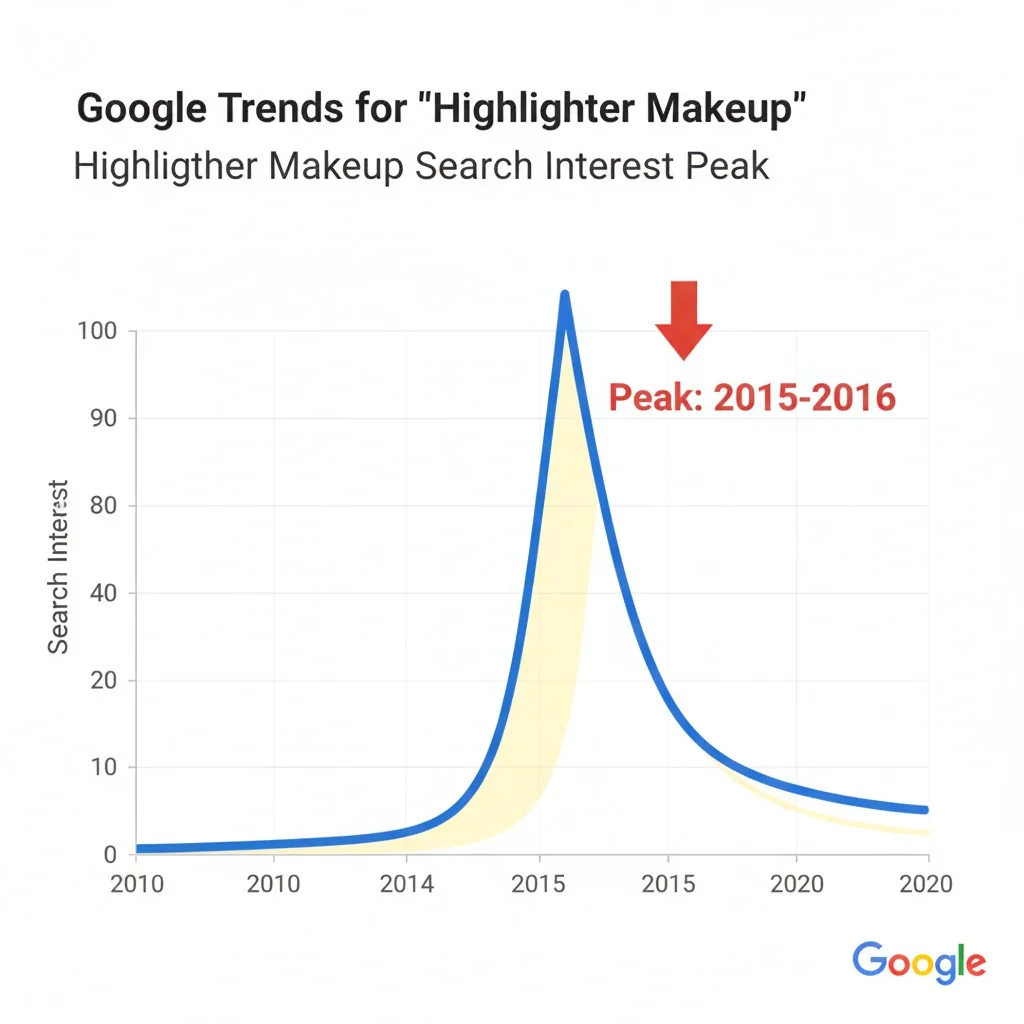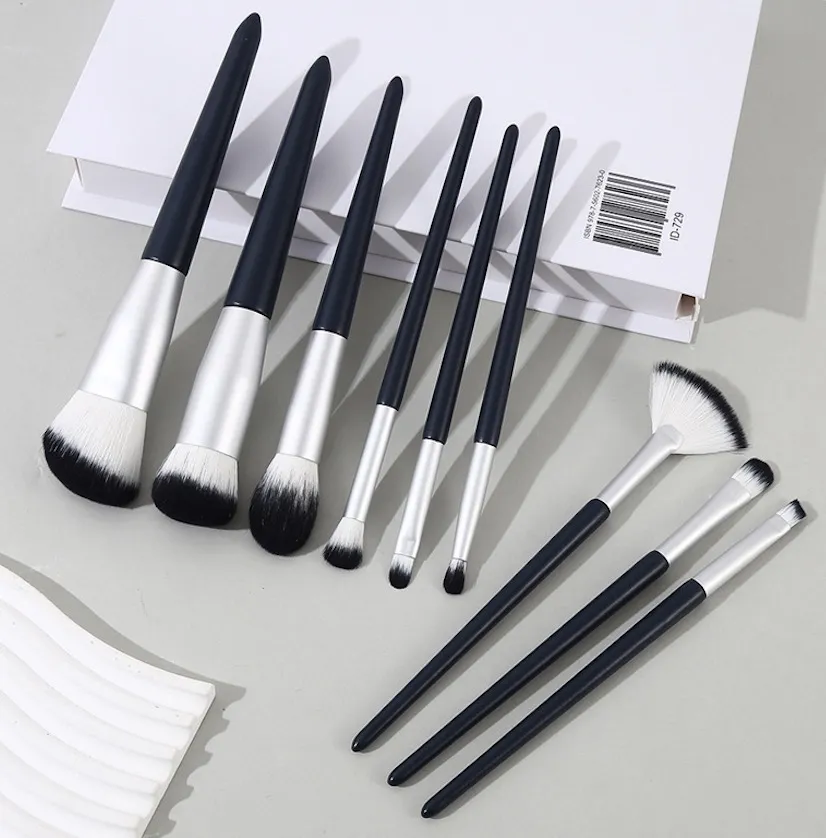Confused about highlighter’s true origin? It’s not just one product but a timeline of innovation. I’ll guide you through its evolution from studio secret to makeup staple.
Highlighter makeup as a product category started in the early 1990s with YSL Touche Éclat1 (1992). It went mainstream with MAC Strobe Cream (2000) and peaked during the 2015–2016 “strobing” trend. Today’s formulas favor sheer, skin-real glow over heavy shimmer.

So, we know the key dates. But how did we get from subtle brightening to the blinding glow that defined a generation of makeup lovers? The journey from a film set trick to a global beauty category is a fascinating story for any brand founder. It shows how a technique can become a product, and how a product can define a trend. Let’s explore the full origin story.
The 'strobing' trend peaked in popularity around 2015-2016.True
Google Trends data and media coverage confirm a massive spike in interest for 'strobing' and 'highlighter makeup' during this period, driven by social media.
YSL's Touche Éclat was the first-ever highlighter product.False
While a pivotal launch in 1992, it was a highlighting *pen* for brightening, not a shimmery powder. The concept of highlighting existed in pro-MUA kits long before.
The Origin Story—From Hollywood Glow to Category Birth?
Think highlighter is a recent invention? Its real story began on Hollywood film sets, using light to sculpt faces long before it was a product in a compact.
Highlighter evolved from professional makeup artists using lighting and custom mixes to create a "glow" on camera. YSL’s Touche Éclat (1992) and MAC’s Strobe Cream (2000) were pivotal products that brought this professional technique to consumers, creating a new product category.

The idea of using light to enhance facial features isn’t new. In the golden age of Hollywood, makeup artists were masters of illusion. They didn’t have "highlighter"; they used Vaseline, powders, and clever lighting to make stars like Marlene Dietrich appear luminous on black-and-white film. This was a technique, not a product. The first major shift came in 1992 with YSL’s Touche Éclat. It wasn’t a shimmer bomb. It was a sheer, light-reflecting liquid in a click-pen, designed to brighten under-eyes and high points. It was revolutionary, reportedly selling six pens per minute. This was the birth of the "highlighting" concept for consumers. Then, in 2000, MAC launched Strobe Cream. As makeup artists told NewBeauty in 2021, this was the product that brought a pearlescent, moisturized glow to the masses. It bridged the gap between skincare and makeup. From my perspective in product development, these two launches created the foundation for the entire category. They proved there was a market for products dedicated solely to adding light and dimension.
MAC Strobe Cream was launched in 2016.False
MAC Strobe Cream was launched in 2000. The brand expanded the shade range in 2016 to meet growing demand during the strobing trend, as reported by Refinery29.
YSL Touche Éclat sells six pens every minute.True
This is a widely reported statistic by YSL and beauty media, highlighting its iconic status and commercial success since its 1992 launch.
Pigments, Textures, and Tools—What Makes a Highlighter “Highlight”?
Ever wonder what makes a highlighter shine? It’s not magic, but a precise science. The wrong formula or tool can create a chalky stripe instead of a seamless glow.
Highlighters work by using light-reflective pigments2 like mica and titanium dioxide. The size of these particles determines the finish—from a subtle sheen to a metallic shine. The base formula (liquid, cream, or powder) and the brush shape control the final payoff on the skin.

From a manufacturing standpoint, a highlighter’s "glow" is a carefully engineered system. It’s all about how light interacts with the product on your skin.
The Science of Glow: Pigments and Particles
The core ingredients are light-reflective agents.
- Mica and Titanium Dioxide (TiO₂): These are the workhorses. Mica provides the pearlescent shimmer, while TiO₂ adds brightness and opacity. As a manufacturer, we must ensure our mica is ethically sourced and that all pigments comply with regulations like the FDA’s color additive guidelines.
- Particle Size: This is critical. Smaller particles (5-15 microns) create a subtle, wet-look sheen. Larger particles (20-50 microns) produce a more visible, metallic, or glittery effect.
The Formula Base: From Balm to Powder
The pigments need a delivery system.
- Anhydrous Balms/Creams: These oil-based formulas give a dewy, "wet-skin" finish.
- Liquid Emulsions (Oil-in-Water): Think MAC Strobe Cream3. These offer a natural, blendable glow.
- Pressed Powders: The most common format, offering high impact and control.
The Tool: Why Brush Geometry Matters
The brush is not an accessory; it’s part of the application system. A fan brush picks up less product for a diffused look. A dense, tapered dome concentrates cream or liquid for a precise pop. This is why we advise clients to develop their brushes and formulas together.
| Finish target | Pigment approach | Typical particle size (µm) | Base system | Recommended brush |
|---|---|---|---|---|
| Wet-skin sheen | Low-load mica, film-former | 5–15 | Balm/cream | Tapered dome (synthetic) |
| Natural glow | micro-fine mica4 + TiO₂ blend | 10–30 | Liquid emulsion | Duo-fiber stippling |
| Metallic pop | Higher-load pearls, specialty interference | 20–50 | Pressed powder | Fan brush for controlled sweep |
The size of the shimmer particles in a highlighter affects its finish.True
Yes, micro-fine particles (under 30 microns) create a smooth, natural sheen, while larger particles (over 50 microns) result in a more glittery, high-impact metallic finish.
Mica is a synthetic ingredient created for makeup.False
Mica is a naturally occurring silicate mineral. Due to ethical concerns with natural mica mining, many brands now use synthetic, lab-created fluorphlogopite, which offers high purity and sparkle.
Market Milestones and Trend Data—When Did Glow Go Mainstream?
Remember when everyone was "strobing"? That trend didn’t happen overnight. Data shows a clear timeline of how highlighter went from a niche product to a global phenomenon.
The highlighter market5 exploded around 2015-2016, driven by the social media "strobing" trend. Google Trends shows a sharp rise in searches then. This led to blockbuster products like BECCA’s "Champagne Pop," which became a top-seller in the U.S. according to NPD Group.

The journey from a pro-MUA secret to a mainstream obsession has clear milestones. After YSL and MAC laid the groundwork, the category simmered for years. The real explosion happened with the rise of social media.
The "Strobing" Boom
Around 2015, the term "strobing"—highlighting without contouring—took over. A quick look at Google Trends data for "highlighter makeup" shows a dramatic spike globally during 2015-2016. Beauty influencers on YouTube and Instagram showcased intense, reflective glows, and brands responded. This era gave us iconic best-sellers. BECCA’s Shimmering Skin Perfector in "Champagne Pop," created with influencer Jaclyn Hill, became a phenomenon. In 2020, the NPD Group named it the best-selling highlighter in the U.S., a testament to its impact.
The Shift to "Skin-Realism"
Today, the trend has softened. While the metallic pop is still an option, many consumers now prefer a more "skin-real" or "glass-skin" finish. This means formulas are becoming sheerer, with finer particles for a believable, dewy look. For brand founders, this is a key insight. Your highlighter assortment needs to cater to both the high-impact lovers and those seeking a subtle, everyday glow.
BECCA's 'Champagne Pop' was the best-selling highlighter in the world.False
The NPD Group reported it as the #1 best-selling highlighter in the U.S. in 2020. While incredibly popular globally, the specific claim refers to the U.S. market.
The term 'strobing' refers to a technique of using only highlighter to sculpt the face.True
Correct. Strobing focuses on applying highlighter to the high points of the face where light would naturally hit, creating dimension without the use of darker contour shades.
Spec’ing for Success—How Should Brands Build Highlighters and Brushes Together?
Developing a new highlighter? A great formula can be ruined by the wrong brush. To succeed, you must think about the product and its applicator as a single system.
Brands should develop highlighters and brushes together. Match the formula (powder, cream, liquid) to the brush shape (fan, tapered, duo-fiber) to control the finish. Offer shades across undertones (gold, pearl, peach) and ensure ethical sourcing and quality control for consumer trust.

As a manufacturer, I’ve seen brands succeed and fail based on their product development strategy. For highlighters, success means thinking about the formula, shade, and brush as one cohesive unit. Here’s how we guide our clients.
1. Match Formula to Brush
We already discussed how brush geometry impacts payoff. A brand should spec these together. If you’re creating a sheer balm for a "wet-skin" look, a dense dome brush is perfect for targeted application. For a high-impact powder, a fan brush offers a diffused sweep, while a smaller, denser brush provides that pop. We establish brush-laydown Standard Operating Procedures (SOPs) to ensure the payoff is consistent from batch to batch.
2. Strategize Your Shades
A single "universal" shade is a myth. A successful range considers undertones.
- Warm Undertones: Gold, champagne, bronze.
- Cool Undertones: Pearl, silver, icy pink.
- Neutral Undertones: Peach, rose gold.
Offer a gradient of intensity within each undertone family to cater to a wider range of skin tones.
3. Build in Trust and Quality
Today’s consumer is savvy.
- Sustainability: Use ethically sourced mica6 with clear audit trails. We help clients source materials from suppliers who are part of the Ethical Mica Initiative. Using post-consumer recycled (PCR) materials for compacts or pens also builds buyer confidence.
- Quality Control: We test highlighter payoff under mixed lighting conditions (from warm 2700K to cool 6500K) to ensure the glow looks good everywhere, not just in a studio.
A 'universal' highlighter shade works perfectly for all skin tones.False
This is a marketing term. While some shades (like champagne or peach) are versatile, a single shade cannot perfectly complement the full spectrum of skin tones and undertones.
Ethically sourced mica is a key consideration for conscious beauty brands.True
Yes, due to issues of child labor and unsafe conditions in some mica mines, brands are increasingly demanding transparent, ethical sourcing, often verified by groups like the Responsible Mica Initiative.
Frequently Asked Questions
-
When was highlighter makeup invented?
Modern highlighter products emerged in the early 1990s (e.g., YSL Touche Éclat, 1992), and the category mainstreamed with MAC Strobe Cream in 2000, with social media “strobing” popularizing stronger highlight around 2015–2016. -
Who invented highlighter?
There’s no single inventor. Techniques evolved from Hollywood lighting tricks, and brands like YSL and MAC commercialized highlight-forward products. -
What pigments make highlighters glow?
Micro-fine mica, titanium dioxide, and specialty pearls (interference pigments) reflect and scatter light. Particle size and load determine subtle sheen vs. metallic shine. -
What brush is best for highlighter?
It depends on the formula and desired finish:
▫ Fan: Soft, diffused glow with powders.
▫ Tapered/dome: Precise placement for liquids/creams.
▫ Duo-fiber: Buildable, translucent blending. -
Did strobing replace contouring?
No. Strobing became a major trend in 2015–2016 favoring highlight-only looks, but contouring remains a popular technique. Many brands now offer products that support both, as well as more subtle, skin-real finishes.
Conclusion
From Hollywood secret to a makeup essential, highlighter’s evolution is a story of science and trends. Developing the right formula, shade, and brush together is key to creating a successful product.
References
-
Explore the iconic status of YSL Touche Éclat, a revolutionary product that changed the makeup industry. ↩
-
Understand the science behind highlighters and the role of light-reflective pigments in achieving a glow. ↩
-
Learn about MAC Strobe Cream’s impact on the beauty market and its role in popularizing highlighters. ↩
-
Explore the properties of micro-fine mica and its importance in creating high-quality highlighters. ↩
-
Investigate the trends and data that led to the explosive growth of the highlighter market. ↩
-
Learn about the significance of ethical sourcing in the beauty industry and its impact on consumer trust. ↩


